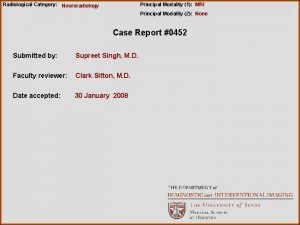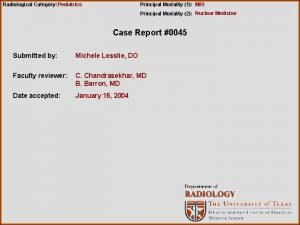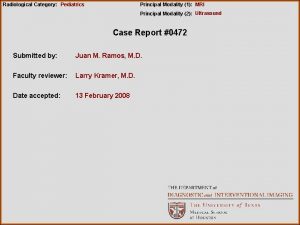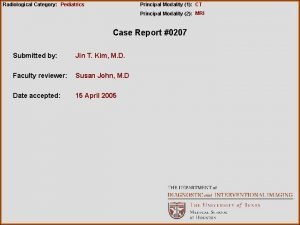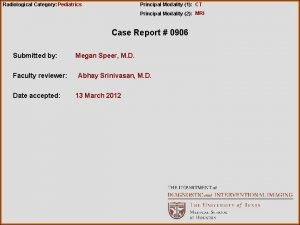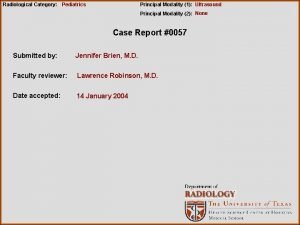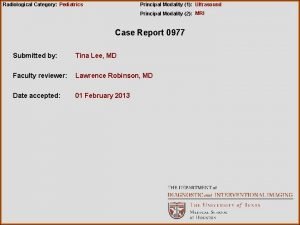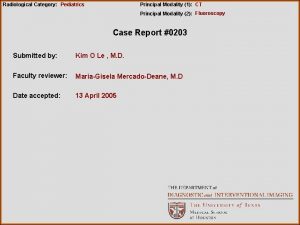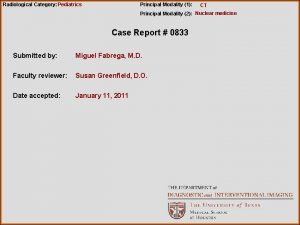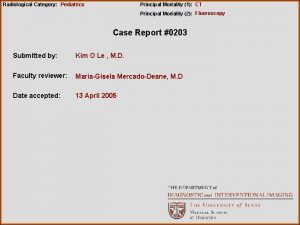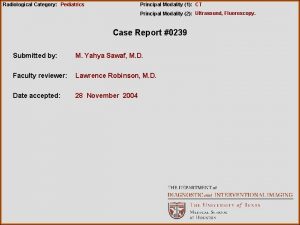Radiological Category Pediatrics Principal Modality 1 MRI Principal











![References Van der Harst E, de Herder WW, Bruining HA, et al. [123 I] References Van der Harst E, de Herder WW, Bruining HA, et al. [123 I]](https://slidetodoc.com/presentation_image/31b143bac2d448af510746faf6cf8643/image-12.jpg)
- Slides: 12

Radiological Category: Pediatrics Principal Modality (1): MRI Principal Modality (2): Nuclear Medicine Case Report #0499 Submitted by: Andrew Potter, M. D. Faculty reviewer: Lawrence Robinson, M. D. Date accepted: 17 March 2008

Case History A 14 -year-old male with attention deficit hyperactivity disorder presents with a 1 month history of sharp headaches, felt primarily above his orbits. On physical exam, his blood pressure is noted to be elevated, repeatedly measuring greater than 160/100 mm. Hg. Biochemical and imaging work-up was initiated.

Radiological Presentations Longitudinal and transverse images superior to the right kidney

Radiological Presentations Axial T 1 -Weighted post-Gadolinium and non-enhanced coronal T 2 -Weighted MR images

Radiological Presentations Whole body and coronal tomographic Indium-111 octreotide images

Test Your Diagnosis Which one of the following is your choice for the appropriate diagnosis? After your selection, go to next page. • Adrenal Adenoma • Oncocytoma • Pheochromocytoma • ACTH – Independent Macronodular Adrenal Hyperplasia • Adrenal Cortical Carcinoma

Findings and Differentials Findings: Ultrasound images demonstrate a solid 6 cm mass superior to the right kidney. The transverse image shows the mass in close approximation to the liver and gall bladder with internal vascularity. MR imaging confirms that the mass arises from the right adrenal gland. Early contrast enhancement is demonstrated on the T 1 W sequence. The tumor is slightly hyperintense on the T 2 -weighted image. Of note, the left adrenal gland is unremarkable. Nuclear medicine octreotide imaging demonstrates increased uptake in the right adrenal mass suggesting somatostatin receptors and a neuroendocrine origin. Differentials: • Pheochromocytoma • Adrenal Adenoma • Adrenal Cortical Carcinoma

Discussion Biochemical analysis revealed plasma normetanephrine levels of 34. 3 nmol/L (normal range <0. 90) and moderately elevated vanillylmandelic acid levels in the urine. The tumor was resected and pheochromocytoma was confirmed by pathology. Pheochromocytomas are catecholamine-producing tumors of chromaffin cell origin, and are found in 0. 2 -0. 4% of patients with persistent diastolic hypertension. These tumors commonly present in the fourth and fifth decades of life. While most are located in the adrenal medulla (85%) and benign (90%), extra-adrenal pheochromocytomas (or paraganglioma) occur 30% of the time in the pediatric population. Extra-adrenal pheochromocytomas are also more likely to be malignant (up to 35%). Diagnosis is made with biochemical analysis, primarily elevated levels of catecholamine in a 24 -hour urine collection. Imaging is performed for anatomic localization and may be accomplished with CT or MRI.

Discussion MR is reported to be more sensitive for the diagnosis of pheochromocytoma due to superior soft tissue contrast resolution, and the ability to differentiate the tumor from adrenal adenoma. T 2 hyperintensity is characteristic, as is early enhancement with slow washout. Metaiodobenzylguanidine (MIBG) is taken up by catecholamine secreting cells and is thus useful for demonstrating the neuroendocrine nature of the tumor. Iodine 123 MIBG imaging is superior to I-131 due to superior photon flux and count statistics. Seratonin receptor imaging may also be perform with Indium-111 octreotide imaging. Sensitivies of 90% have been demonstrated for head and neck paragangliomas, however this falls to 25 -30% for adrenal pheochromocytomas due to the relatively high uptake of the adjacent kidney. Nevertheless, octreotide scans have proven useful for revealing metastatic disease, as these foci may secrete less catecholamines and therefore be missed with I-123 MIBG imaging.

Discussion Oncocytoma, the most common benign renal mass, can be discounted as the ultrasound and MR images show an adrenal mass distinct from the kidney. Adrenal cortical carcinoma would be unlikely given the age of the patient, occurring in a bimodal distribution with clusters <6 years of age and at 50 -60 years of age. Furthermore, metastatic spread of disease would be expected with such a large tumor. As previously mentioned, adrenal adenomas exhibit quicker contrast washout than pheochromocytomas on both CT and MR exams. The positive octreotide scan argues for a neuroendocrine tumor, further differentiating among these entities. ACTH-independent macronodular hyperplasia is a rare cause of Cushing’s syndrome. Large bilateral adrenal nodules are present.

Diagnosis Pheochromocytoma
![References Van der Harst E de Herder WW Bruining HA et al 123 I References Van der Harst E, de Herder WW, Bruining HA, et al. [123 I]](https://slidetodoc.com/presentation_image/31b143bac2d448af510746faf6cf8643/image-12.jpg)
References Van der Harst E, de Herder WW, Bruining HA, et al. [123 I] Metaiodobenzyguanidine and [111 In] Octreotide Uptake in Benign and Malignant Pheochromocytomas. The Journal of Clinical Endocrinology and Metabolism 2001; 86: 685 -693. Blake MA, Kalra MK, Maher MM, et al. Pheochromoctyoma: An Imaging Chameleon. Radio. Graphics 2004; 24: S 87 -S 99. Manger WM. An Overview of Pheochromocytoma. Annals of the New York Academy of Science 2006; 1073: 1 -20. Reisch N, Peczkowska M, Januszewicz A, et al. Pheochromocytoma: presentation, diagnosis and treatement. Journal of Hypertension 2006; 24: 2331 -2339. Slapa RZ, Jakubowski W, Feltynowski T, et al. Multiple adrenal masses: MRI tissue differentiation of pheochromocytoma and adenoma at 1. 5 T. European Radiology 1997; 7: 3840.
 Pa erate
Pa erate Tennessee division of radiological health
Tennessee division of radiological health Center for devices and radiological health
Center for devices and radiological health National radiological emergency preparedness conference
National radiological emergency preparedness conference Radiological dispersal device
Radiological dispersal device Mri principal
Mri principal Past tense in xhosa
Past tense in xhosa Modality in software engineering
Modality in software engineering Deontic and epistemic modality exercises
Deontic and epistemic modality exercises Modality in software engineering
Modality in software engineering Cardinality and modality in database
Cardinality and modality in database Lexical vs auxiliary verbs
Lexical vs auxiliary verbs Medium modality
Medium modality





